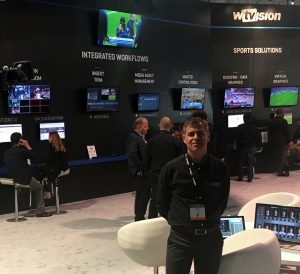NAB Reflections: wTVision’s Mário Sousa on the Importance of Being Agnostic
Software offerings for sports production integrate with a variety of technologies, including AR
Story Highlights
wTVision was at NAB 2018 last week showcasing the latest releases of its end-to-end software offerings for sports productions, master-control rooms, production-control rooms, and more. Among the demonstrations at the booth were cloud playout (in partnership with ATEME), sports scouting, on-air graphics and video controllers, media-asset management, ingest, virtual graphics, and, most eye-catchingly, augmented reality. In the AR demo, wTVision deployed a Blackmagic camera on a jib outfitted with Stype tracking technology and, using its core graphics engine, integrated AR graphics into the feed.
SVG took some time with wTVision CEO Mário Sousa to discuss the parade of demos, the excitement surrounding AR, how the company balances its role as a technology vendor and services provider, and more.
What is wTVision’s main theme here at its NAB 2018 booth?
The goal here is to show everything that we do and also incorporate other companies from [our partner] MediaPro, such as Omnicam4Sky and AutomaticTV.
The big thing at [NAB 2018] is our R3 Space Engine. Development of our engine started five years ago, and the goal was mainly to develop a graphics engine for the master-control room, so that we could have our own engine for Channelmaker-in-a-Box. That was necessary if you just wanted to have [basic graphics]. The goal is not to sell the engine as a separate product as all the [graphics vendors] do. What we do is to incorporate it with all of our products, and you can see all the products we have here [at the booth].
What is new this year?
Each year, we are incorporating more features, and the big new feature this year is, we are showing augmented reality for the first time. This is a great example of what we can do with our engine, which is already AR-compatible, to add augmented reality. It can be integrated into any camera, any lens, any crane, any tracking [system]. Everything that we can already do on the real-time–graphics side we can do now with AR. Here, we are using Stype tracking and a Blackmagic camera, but it can be any camera or tracking [system].
The good thing about this [solution] is not only the portability but also how cheap it can be. In the past, to use augmented reality, you had to have a huge infrastructure. But we are doing it here with a laptop.
Is this offering a result of increased demand for AR among sports customers?
We have definitely seen a lot [of demand for AR], both in studios and in sports [venues]. The goal here is to integrate with all the manufacturers, all the tracking systems, all the camera systems, including our partner Omnicam4Sky, which has an aerial camera that we are already integrated with. Several stadiums in Spain have already installed that aerial camera. But our logic is to be agnostic as ever.
wTVision is unique in offering comprehensive permanent workflows for broadcasters, as well as services for one-off events on a limited budget. How does this reflect your product strategy?
It’s important for us to be flexible, because it’s not only to sell and provide products: typically, we are also a service provider. We want to be very flexible when a customer [wants] something different two weeks [before the event]. The only way to do that is to develop everything to be very flexible and to be prepared. One of the key points is that everything that you can see [at the booth] — the augmented-reality graphics, Studio CG for studio graphics, Channelmaker for master control, data and sports graphics for live games — is done with our engine, and everything is done with portable solutions. It’s a very key point for us, because, at the end of the day, we want to keep rolling out around the world and the only way to do that is to do everything with portable solutions.
How important are third-party technology partners when you’re developing agnostic solutions like these?
At the end of the day, we are growing with our own solutions, and we need integrated third-party technologies to do that because we don’t want to develop everything ourselves. When we need hardware, we have partners that we trust. And we keep it as agnostic as possible.
This interview has been edited for length and clarity.

